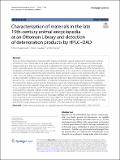Please use this identifier to cite or link to this item:
http://hdl.handle.net/11547/11589| Title: | Characterization of materials in the late 15th-century animal encyclopedia at an Ottoman Library and detection of deterioration products by HPLC-DAD |
| Authors: | Torgan Güzel, Emine |
| Keywords: | IRON-GALL INKS RAY-FLUORESCENCE ANALYSIS |
| Issue Date: | 2023 |
| Series/Report no.: | 11;1 |
| Abstract: | There are many manuscripts in institutions that preserve and exhibit cultural heritage such as museums, galleries, and libraries. These manuscripts are of great value because of their witnessing to the past and the historical and cultural significance they have accumulated. In addition to the organic nature and the natural aging of the paper, which is generally used as the primary carrier material in these objects, other materials used in the manuscripts are an obstacle to their preservation and reaching future generations. In this study, the 62-volume animal encyclopedia, which is known to be written in the name of animals, plants, and Islamic science at the end of the fifteenth century (1487-1501) and added to an Ottoman Library, was examined analytically. A total of 40 samples consisting of paper, ink, dye, and leather samples were analyzed using high performance liquid chromatography with a diode array detector (HPLC-DAD). After all, information on material characterization and deterioration product(s) was obtained. As a result of the analysis, vanillic acid, and its derivatives due to the natural aging of the paper and chrysophanic acid and its derivatives caused by fungi, which are the result of unfavorable environmental factors, were determined. It was concluded that the ink used in the manuscripts was iron-gall ink. In addition, it was determined that madder, weld, buckthorn, redwood, rhubarb, or dock plants were used as dyestuffs in paper and leather samples. Also, it was deduced that the leather samples were tanned with the vegetable tanning method using tannins. Since tannic acids were determined in the dyestuff analysis of three paper samples with ink, elemental analysis was performed on black ink by scanning an electron microscope with energy-dispersive X-ray spectroscopy (SEM-EDX). As a result of this analysis, the element of iron has been detected and it has been confirmed that the black ink is iron-gall ink. It is inevitable that this study will guide conservation experts in restoration and conservation studies. |
| URI: | http://hdl.handle.net/11547/11589 |
| ISSN: | 2050-7445 |
| Appears in Collections: | Web Of Science |
Files in This Item:
| File | Description | Size | Format | |
|---|---|---|---|---|
| s40494-023-00968-7.pdf | 4.09 MB | Adobe PDF |  View/Open |
Items in DSpace are protected by copyright, with all rights reserved, unless otherwise indicated.
